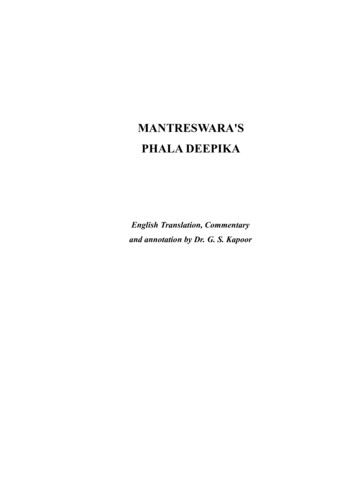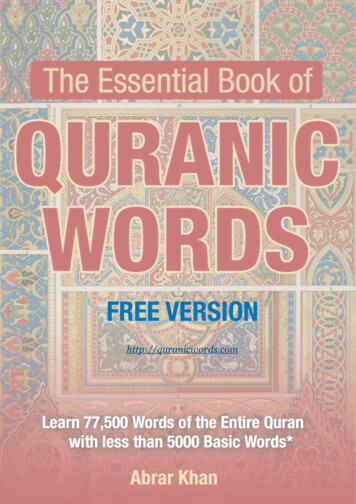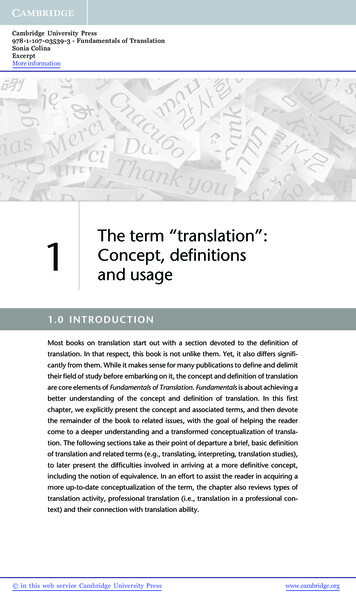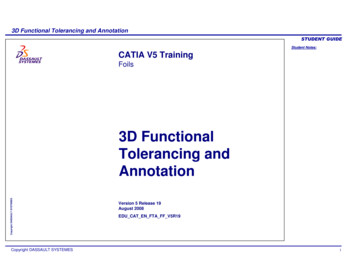
Transcription
MANTRESWARA'SPHALA DEEPIKAEnglish Translation, Commentaryand annotation by Dr. G. S. Kapoor
PrefaceShri Mantreswara's 'Phaladeeplka' holds a most distinguished positionamongst the great ancient astrological classics alongwith Brihat Parasara HoraSastra, Varahmihira's Brihat Jataka and Vaidya Natha's Jataka Parijata. It deals in amost comprehensive and authoritative manner with almost all the astrologicalaspects of human life. There can be said to be nothing that this great work hasomitted from its purview.Some of the important subjects dealt with in a lucid manner in the book are:description and characteristic features of the various signs, planets and bhavas(houses), the various kinds of strengths of planets and their awasthas with theireffects, sources of livelihood, yogas or planetary combinations leading to affluenceand poverty, effects of planets in different houses, effects of different Ascendants,Female horoscopy, matters relating to matrimony and progeny determination oflongevity, judgment of houses, various kinds of Dasas and their effects,Ashtakavarga and its importance in the judging of effects of transit of planets,transit effects of planets and constellations, and description and influence ofupagrahas.The author of this book Shri Mantreswara is believed to have lived in the13th century when this valuable work must have been compiled. It is said that hebelonged to a family of Namboodari Brahmins and he was born in tirinevelleyDistrict of the erstwhile Madras Presidency (now known as Tamil Nadu). He was adevotee of Sukuntlambki Devi. As a young man his name was MarkandeyaBhattadri. To attain knowledge he is said to have travelled to far off places likeBadrika Ashram in Himalayas and Mithila Pradesh - By sheer dint of hard workand devotion, he became well versed in the Vedanta philosophy and in theknowledge of other sastras, and by severe observance of fast, penance andmeditation, he became gifted with divine knowledge and assumed the name ofMantreswara. His knowledge of Astrology was profound and the reference in hisbook to Parasara, Varahamihira and other learned astrologers indicates that he had2
made a deep study of all the ancient astrological works existing in his time.The present book is so instructive that beginners as well as advancedstudents of Astrology can obtain very useful guidance from its study.New DelhiG.S. Kapoor3
Table of ContentsChapter 1: Description of characteristicJeatures of signs and houses Parts of the body of Kalapurusha, Abdoes ofsigns -- Lords of the signs -- Moolatrtkona signs, exaltation and debilitation points,own signs of planets- Biped, centiped, watery and quadruped, Shlrshodaya-Nocturnal and diurnal signs - Moveable, fixed and common signs -- Dwara, Bahisand Oarbha signs - Dhatu, Mula and Jeeva signs -- Krura, Saumya, odd. even,male, female signs - Twelve houses and subjects with which they are concerned. 111Chapter 2: Characteristic features of the planets and the mattersJailing under their Jurisdiction Subjects to be determined from the Sun andother planets-temperament, form, colour, dress, appearance, etc., of the planets,places belonging to the planets Gunas, Satwa, Rajas and Tamas of planets-relations signified by them-Grains, gems and substances ruled by the planets-Agesindicated by the planets. 12-27Chapter 3: Divisions of a signRasi, Hora, Drekkana, Panchamsa, Saptamsa, Navamsa, Dasmainsa,Dwadasauisa, Shodasamsa and Shastyamsa -- Saptavargas consisting of vargasafter omitting Dasmamsa, Shastyamsa and Shodasamsa -- Shadvargas - Matters tobe considered from various vargas and their significance -- meaning andsignificance of Vargottama -Parljatamsa, Uttamamsa, Gopuramsa, Slmhasanamsa,Parvatamsa, Devalokamsa, Alravatamsa and Suralokamsa -- Awasthas of planets Pradeepta, Sukhita, Swastha, Mudita, Shanta, Shakta; Vlkala, Nlpldlta, Khala andAtibhjeeta -- Effects of Planets In various conditions. 28-36Chapter 4: The strength of planets and housesKalaja, Chesta, Uchchaja - Dik -Ayan -Sthana. The method of working outChandra krlyas, Chandra Awastha and Chandra Vela -Effects of 60 Chandra krlyas,12 Chandra Awasthas and 36 Chandravelas -- Tables for guidance. 37-56Chapter 5: Source of livelihood4
The indication of the sources of livelihood or profession by the Sun andother planets. 56-60Chapter 6: YogasPanchamahapurusha yogas viz., Ruchaka, Bhadra, Hansa, Malavya andSasa. — Sunapha, Anapha and Durudhara -Kemadruma - Papavasl and Papakartarl- Amala - Mahabhagya » Kesari - Sakata - Adhama, Satna and Varlshta -- Vasumatl— Pushkala -- Shubhamala and Ashubhamala -- Lakshml -- Gouri -- Saraswatl -Srikanta - Srinatha -- Varunchi — Parivartana, Kahala — Raja yoga — Sankhyayogas viz. Veena, Dama, Pasa, Kedara, Sula, Yoga, and Gola — Adhiyoga -Chamar, Dhenu, Saurya, Jaladhi. Chhatra, Astra, Kama, Asura, Bhagya, Khyatl,Partjata and Musala yogas -- Avayoga, Nisswayoga. Mriti yoga, Kuhu yoga, Sarlayoga, Nlrbhagya yoga, Duryoga, Dartdrayoga and Vimala yoga. 61-89Chapter 7: Raja yogasDescription of various planetary combinations. 90-100Chapter 8: Effect of the Sun and other planets In the twelve houses.101-116Chapter 9: Effect of different AscendantsEffects of planets posited in exaltation, own, friend's, Inimical and debilitation 117122Chapter 10: Matters relating to the 7th housePlanetary dispositions for loss of wife,. issuelessness, possessing a chaste,fortunate and beautiful wife, a crippled wife, liasion with other people's wives,wlfelessness, having two wives, time of marriage. 123-127Chapter 11: Female HoroscopyPeculiarities of female's horoscope -- planetary combination for a goodhusband and sons, masculine featured and sons, masculine featured anduncontrollable woman — planetary combination for widowhood, diseased womb,lack of chastity, becoming a prostitute, being chaste, happiness - Effects ofTrimsamsa occupied by the Moon at birth-untoward effects of the birth, a female in5
certain Nakshatras — Circumstances favourable for conception. 128-134Chapter 12: Birth of children (the 5th house)Planetary combinations for acquisition of children issuelessness, loss ofchildren, limited progeny, having a child late In life, having a son from the secondwife, extinction of family, having a son by adoption, male and female children,number of Issues and having children with great efforts -- Inauspicious Tithis forbirths and their adverse effects and remedial measures for the same -- Method forfinding out the Dasa and Antardasa — Effects of transit of planets on the birth ofchildren. 135-145Chapter 13: Determination of longevity Essentials at the time of birthEarly death due to own signs or those of father and mother and tlife),Madhyamayus,circumstances In which father or mother or both will die after the birth of a child -Evil yogas viz. Dinamrityu, Dinaroga or Vlshaghatlka, death soon after birth -fateful degrees of the Moon which cause early death. The decanate Rasls of theLagna and the Moon, Navamsa Rasls of the lord of the Lagna and lord of the signoccupied by the Moon and the Dwadasamsa Rasls of the lord of Lagna and the lordof 8th house -- Planetary combinations of long, medium and short life -- Evileffects by a strong Jupiter posited In the Lagna, happy long life If Jupiter and lordof the Lagna are posited In Kendra. 146-156Chapter 14: Diseases, death and past and future birthsDescription of diseases by the various planets - Planetary combinations foroccurrence of different kinds of diseases - Manner In which a person meets withhis death -Description of planets and Rasis and the diseases caused by them.Planetary combinations for happy and troublesome deaths and going to heaven orhell -- Planets which give information about past and future births. 157-166Chapter 15: Assessment of housesCircumstances in which the various houses are strong and when they areweak -circumstances causing total destruction of a house-Description of planetscausing destruction of the house during their Dasa period -- Good effects of lord of6
the Lagna occupying a house even if he be a malefic -- Effect on the house when aplanet owns two houses -- Effect of a planet in Bhava -- Sandhi -- Description ofsubjects falling under the Jurisdiction of the various planets -- Karakas -- a methodof judging each house -- Circumstances under which the planets are Interconnected. 167-177Chapter 16: General effects of the twelve housesThe planets effecting the appearance of the native and his body and limbs -Effects of the good and had disposition of the lords of the Lagna and other houses-- Effects of the lord of Lagna being stronger than the lord of the 6th house -- Timewhen the good and bad effects of a house will be realised. 178-188Chapter 17: Exit from the worldDestruction of a house during transit of Saturn through certain positions Occurence of death during the transit of Saturn through certain positions Occurence of death during transit of Jupiter, the Sun and the Moon In certainpositions - The time of death of the native. 189-196Chapter 18: Effects of conjunction of two planetsGeneral effects of conjunction of two planets - Effects of Moon in differentsigns being aspected by different planets - Effects of the Moon being in Navamsaof different planets and being aspected by them. 197-202Chapter 19: Dasas (major periods) of planets and their effectsThe span of Dasa (Vlmshottari Dasa) of various planets — How to work andthe balance of dasa at birth? – What is a solar year? -- General effects of Dasas ofthe various planets. 203-213Chapter 20: Effects of the Dasas of the lords oj housesEffects of the Dasa of Vargottamamsa planets -- Unfavourable effects of theDasa and Antar Dasa of the two planets occupying the 8th house -- Effects of theAntar Dasa of a planet owing to the 3rd, 5th, or 7th star from the natal star in theDasa of a Malefic - Evil effects If the 4th Dasa is of Saturn, sixth of Jupiter and 5thof Mars of Rahu -- Favourable effects of the Dasa of Mars if in Urdhvamukha signof the exaltation sign - identical with the 10th or 11th house — Unfavourable7
effects of a planet if he is Inimical to the lord of the Dasa -- Quantum of effects ofa planet in his Dasa -- Effects of Antardasa of a planet passing in the course of histransit through his house of depression or Inimical house, house of exaltation, hisown house or a friendly house -- Effects of Dasas of benefics owning kendras andthose of planets in Trtkonas — Effects of Dasas and Antar Dasas of planetsownlng,kendras and occupying Trikonas and vice-versa -- Evil effects of Jupiterand Venus owning kendras — Attainment of yogakarka status by Rahu and Ketu Ifposited In kendra or Trlkona — Avarohlnl and Arohinl Dasas. 214-231Chapter 21: Nature of Antar Dasas and Pratyantar DasasMethod of calculating the spans of Antar Dasas and Pratyantar Dasas -Effects of the Antar Dasas of the nine planets during the Dasas of the Sun, theMoon, Mars, Rahu, Jupter, Saturn, Mercury, Ketu and Venus. 232-251Chapter 22: Kalachakra DasaMethod of preparing a kalachakra - Distinguishing between Apasavya andsavya chakras — Period of the seven planets reckoned from the Sun-Description ofallotment of sub-periods according to four padas of the Nakshatras -- Details ofParama Ayus in years for the 12 Raslamsas reckoned from Aries In the Apasavyachakra and those for the 12 Raslamsas reckoned from Scorpio In the savya chakra-Calculation of cycles of Dasas — Utpanna, Adhana and Mahadasa — NisargaDasa and its details — Amsa Dasa and its details. When the kalachakra Dasasystem has not to be followed? 252-263Chapter 23: AshtakavargaImportance of Ashtakavarga -- Meaning of Ashtakavarga -Reckoning ofauspicious places in the Ashtakavargas of the seven planets and the Lagna -Effects of nil to 8 benefic Blndus (dots) In the Ashtakavargas - Method ofpreparing prastara or Sarvashtakavarga -- Effects of benefic even in his exaltationsigns white owning a Dusthana. 264-276Chapter 24 Effects of Ashtakavarga according to HorosaraSodhyapinda — Method of Trlkona Shodhana -- Method of EkadhlpatyaShodhana -- Description of Rasl multipliers and planet multipliers. 277-2888
Chapter 25: Gullka and other UpagrahasThe names of Upagrahas viz. Gullka or Mandl, Yamakantaka, Ardhaprahara,Kala, Dhuma, Vyatipata, Parldhl, Indra Dhanus and Ketu or Upketu - Calculationof their position and their effects. 289-294Chapter 26: Effects of transits of various planets and constallatlons(Nakshatras)Houses reckoned from the nine planets in which they produce good effectsIn the course of transit — Description of Vedha places from the various planets-transit effects to be reckoned from the sign occupied by the Moon - Effects oftransit of the planets through the twelve houses — Effects of transits of Nakshatras- Saptasalaka diagram- Effects of Lattas-Preparatlon of Sarvatobhadra chakramand Its Importance - Information extracted from Hora Ratna about Sarvatobhadrachakram – Diagram of Samastobhadra chakram. 295-325Chapter 27: Yogas leading to ascetlsmPlanetary combination leading to ascetlsm -- the order of ascetlsm to betaken up as a result of the influence of the seven planets. 326-327Chapter 28: Conclusion 3289
"PHALA DEEPIKA"Chapter 1Information and characteristic featuresof the Signs (Rasis) and the houses (Bhavas)1. May the Supreme Divine Light (the Sun) who once above the horizonremains on end in view for six months (solar) to the pole dwelling Celestials, forhalf a month (Lunar) to the Moon dwelling manes and for 12 hours (entire daytime) to the earth dwelling mortals and some times changes his direction to thenorth (Uttarayan) and some-times to the south (Dakshinayan), bless us withunlimited prosperity, good luck, splendor and beatitude.2. I, the astrologer Mantreswara, first offer my respectful obeisance toSaraswati, the Goddess of speech and learning, to my family deity, to mypreceptors, to the nine planets (the Sun, the Moon, Mars, Mercury, Jupiter, Venus,Saturn, Rahu and Ketu) to Lord Ganesha and Lord Shiva who bestow knowledgeof the past, present and. future, and then give here for the benefit of astrologers alucid version in a simple manner of the teachings of sages Atri and Parasara.3. The first thing is to ascertain the exact time of birth of the native minutelyin Ghatikas, Vighatikas etc., on the basis of tool measurement or by the gnomonicshadow and other apparatus. Then the positions of the planets (longitude) in Rasi(sign), amsa (degrees), Kala (minutes), and Vikala should be worked out by actualobservation and mathematical instruments. The assessment of results should bemade thereafter by taking into account the longitudes of the various houses(Bhavaspast) and the strength of the houses and the planets.4. Assuming that the horoscope represents the Kalapurusha, then the parts ofthe body beginning with the Ascendant (Lagna) will be as under:First house (Lagna-Ascendant)— the headSecond house— the face10
Third house— the breastFourth house— the heartFifth house— the bellySixth house— the waistSeventh house— the groinsEighth house— the private parts (Sexual organs)Ninth house— the two thighsTenth house— the two kneesEleventh house— the two calvesTwelfth house— the two feetThe end portions of the signs Cancer, Scorpio and Pisces are known as RasiSandhisj. There are other learneds who apply this term to the end portions of allsigns.Notes — The house which is occupied or aspected by benefits or whose lordis bestowed with strength, the part of the body represented by that house will bestrong and well built. If the lord of a house be weak or be occupied or otherwiseafflicted by a malefic, the corresponding part of the body will be weak or diseased.5. The dwelling of the twelve signs Aries, Taurus, Gemini, Cancer, Leo,Virgo, Libra, Scorpio, Sagittarius, Capricorn, Aquarius and Pisces are — (1) forest(2) agricultural land with water (3) bedroom (4) chasm with water (5) mountain (6)land with water and food crops (7) house of a Vaishya (8) cavity or a hole (9)residence of the king (10) watery forests (11) the spot frequented or used by pottersand (12) water, in that order.Notes — Generally this information proves useful in queries regarding theftof articles or missing persons etc.6. The lords of the twelve signs are as under:Aries – MarsLibra - VenusTaurus – VenusScorpio - MarsGemini - MercurySagittarius - JupiterCancer - The MoonCapricorn - Saturn11
Leo - The SunAquarius - SaturnVirgo - MercuryPisces - JupiterThe signs of exaltation and fall of the seven planets from the Sun onwardsare as under —PlanetThe SunThe MoonMarsMercuryJupiterVenusSaturnSign of raSign of s means that the seventh or the opposite sign from the sign of exaltationof a planet, is the sign of fall or debilitation.Notes— There is great difference of opinion amongst the ancient learnedsabout the exaltation and debilitation signs of Rahu and Ketu. Mantreswara hasexpressed no opinion in that regard. According to Sarvarth Chintamani theexaltation sign of Rahu is Gemini and his sign of debilitation is Sagittarius.Reverse is the case with Ketu. According to Brihat Parasara Hora Sastra Taurusand Scorpio are respectively the exaltation signs of Rahu and Ketu and the signsopposite to them are their signs of debilitation.The highest points of exaltation and the lowest points of debilitation of thevarious planets are as under:PlanetHighest points of exaltation(Deep exaltation)The SunAries 10th degreeThe Moon Taurus 3rd degreeMarsCapricorn 28th degreeMercuryVirgo 15th degreeJupiterCancer 5th degreeVenusPisces 27th degreeSaturnLibra 20th degreeLowest point of debilitation(Deep fall)Libra 10th degreeScorpio 3rd degreeCancer 28th degreePisces 15th degreeCapricorn 5th degreeVirgo 27th degreeAries 20th degreeNotes — For example Jupiter at the 5th degree of Cancer will be in deepexaltation. Then he moves downwards from that point and gets into deep debilition12
when he reaches 5th degree of Capricorn.7. The Moolatrikona signs of the planets the Sun onward are Leo, Taurus,Aries, Virgo, Sagittarius, Libra and Aquarius respectively. Below are given theportions of the own sign and Moolatrikona from the Sun onwards :—PlanetThe SunThe sVirgoSagittariusLibraAquariusMoola trikona portion0 - 20 4 - 30 0 - 2 16 - 20 0 - 10 0 - 5 0 - 20 Own sign portion21 - 30 13 - 30 21 - 30 11 - 30 6 - 30 21 - 30 The various signs have been classified as biped or human signs, reptile or(Keeta) or centipeds, watery or quadruped (Chatuspada) as detailed below ioLibraSagittarius Leo(first half)Sagittarius(later half)Aquarius Capricorn(first half)WateryCancerCapricorn(later half)Pisces8. The signs which rise with their back (Prishtodaya) are Taurus. Cancer,Aries and Capricorn. The signs which rise both from their back and front(Ubhayodaya) are Gemini and Pisces. The rest appear with their heads are calledSirsodaya signs.The Prishtodaya signs Taurus, Cancer, Sagittarius, Aries and Capricorn andthe Ubhayodaya sign Gemini fall under the jurisdiction of the Moon and aretermed as nocturnal (strong at night). The other signs are governed by the Sun andare known as diurnal signs (strong during day time).Count from the sign last passed by the Sun. The first sign is called Urdhawa13
(bending upwards) the second sign is known as Adah (beneath), the third sign istermed Sama (even) and the fourth sign is known as Vakra (Crooked). The sameorder applies for the other eight signs.Notes — For example the Sun has last passed Virgo. Then the signs fromVirgo to Leo will be in this order - Kanya - Urdhava, Adah, Even, Vakra, Urdhava,Adah, Even, Vakra, Urdhava, Adah, Even.9. The following are some farther classifications and indications of thetwelve signs ableScorpioFixedSagittarius DualCapricorn MoveableAquarius (Garbha)En NorthEastSouthWestNorthEastSouthWestNorthThe six houses from the 7th represent the left side limbs of the Kalapurusha,while the other six houses i.e. those reckoned from the Ascendant represent rightside limbs.10. [In a birth chart there are twelve house. Each house has been givenseveral names indicating the various subjects it deals with.]The names by which the first house or the Ascendant is known are Lagna,Hora, Kalya, Deha, Udaya, Rupa, Seersha, Vartmana (present) and Janma.The second house deals with Vitta (wealth), Vidya (learning). Swa,Annapana (riches, food and drinks), Bhukti (eating), the right eye, face (Asya),letter or document (Patrika), Speech (Vak) and Kutumba (family) and thus adoptsthese appellations.14
11.-12. — The names given (or the subjects allotted) to third house areDuschikya, Uras (breast), the right ear, army valour, prowess and brother.The subjects or designations for the fourth house are house, land, maternaluncle, a sister's son, a relation, a friend, conveyance, mother, kingdom, cow,buffalo, perfume, clothes, ornaments, the nadir, hibuka, sukha (happiness), water,bridge and river.The fifth house deals with (and has designations accordingly) the mark ofthe sovereign, taxes, soul, intelligence, knowledge of the future, life, progeny,belly, Vedic knowledge and other religious scriptures.13. — The sixth house deals with debts, arms, thieves, wounds, diseases,enemies, paternal relations, battle, wicked acts, sins, fear and humilialtion.The subjects dealt with by the seventh house are desire, passion, setting,sexual desire, a way, people, husband road and wife.14. — For the eighth house subjects allotted are Mangalya (the living of thehusband during the life time of the wife), Randhra, filthiness, mental pain, defeator humiliation, longevity, sorrow, blame, death, impurity impediments and slavery.The ninth house deals with preceptor (guru), deity (devta), father,auspiciousness, poorvabhagya (previous luck), worship, penance, virtuous act orvirtue, grand son, and noble family. (Some of the learneds in the North are of theview that all about father should be examined from the 10th house, because 10th is7th to the 4th house dealing with the father. The view of Phaladeepika seems to bebased on the logic that the 9th being 5th to 5th house (dealing with progeny)should be the most appropriate house to be connected with father).15. The subjects (names) designated for the 10th house are business or trade,ranker position, honour, occupation, profession, sky or zenith, conduct, quality,inclination, gait, command and Meshurana (to give orders).The matters to be considered from the eleventh house are gains, income,acquisition, receipt of wealth, accomplishment, splendor and prosperity, profits,veneration, elder brother or sister, left ear, anything juicy, delightful news.16. The expressions used for the twelfth house are misery, leg, left eye, loss,15
spy, last rites, poverty, sins, bad expenditure and imprisonment or confinement.Described above are the designations of the twelve houses or the subjectmatters to be examined from them. The 3rd, the 6th, the 8th and 12th are known asLeena Sthanas (hidden houses).17. The 6th, the 8th and 12th houses are also called Dusthanas (evil houses).The remaining houses are considered good and auspicious. The 1st, 4th, 7th andthe 10th houses are termed as Kendra, Kantaka or Chatushtaya.18. The 2nd, the 5th, the 8th and 11th houses from the Ascendant are calledPanaphara houses. The 3rd, the 6th, the 9th and the 12th are termed as Apoklimahouses. The 4th and the 8th are also known as Chaturasra houses. The 3rd, the 6th,the 10th and 11th are Upachaya houses. The 5th and 9th are called trines (Trikonahouses). The trines have been considered as very auspicious houses.Thus ends the first chapter on "Definitions" in Phaladeepika composed byMantreswara.16
Chapter 2Information and Characteristic features of planetsBefore we come to the verses of this chapter it is necessary to explain itsobjects. In the previous chapter it has been described what each house stands for. Itis proposed to state in this chapter what purpose and what object each planetsignifies.If a house stands for a certain subject matter, the lord of the house will alsobe considered to be concerned with it. For example, the 6th house deals withenemies. Naturally the same subject will have to be examined from the lord of the6th house. This is so because of his lordship of the 6th house. Here we have toconsider also the natural or inherent characteristics and functions of that planet. Letus suppose that in ten birth charts, the Sun is lord of the ten different houses. Thereis doubt that as lord of the Ascendant Sun will function in that capacity and as lordof the 2nd. he will be concerned with wealth; but he will also, in course of itseffects, will produce results of his inherent qualities and characteristics. This iswhat is intended to be explained in this chapter.1. The Sun is the singnificator of the person's collection of copper and gold,and of father, patience, valour, victory in war, one's soul (Atman), auspiciousness,happiness, prowess, power, light, any work relating to Lord Shiva, travels inforests and mountains, havans or yajnas, Inclinations for work, temple, acuteness,enthusiasm. Wise men should act according to these significations.2. The Moon is the signiflcator of the welfare of the mother, tranquilityof themind, bathing in the sea, white chamar, umbrella, good fan, fruits, flowers, tenderobjects, farming grains, fame, pearls, silver, bell metal, beauty. In other words allabout the above matters should be ascertained from the Moon.3. All about one's strength (physical and mental), products produced fromthe earth, qualities of the brothers and sisters, cruelty, battle, courage, antagonism,the fire of the kitchen, gold, kinsmen, weapons, thieves, enemies, enthusiasm,sexual intercourse with another man's wife, falsehood, prowess, high thinking, sin,17
wounds, and acquisition of the position of a commander-in-chief should beascertained from Mars.In other words Mars is the signiflcator of these matters.4. From Mercury is to be ascertained all about learning, eloquence,proficiency in arts, praise by learned people, maternal uncle, dexterity in speech,aptness for acquiring knowledge, expertise in ways of worship, intelligence,religious acts relating to Lord Shiva, truthfulness, oyster, spots of recreation andenjoyment, skill in mechanical arts, kinsmen, heir apparent, friends, sister's sonsand daughters etc.5. Jupiter is concerned with matters relating to knowledge, noble qualities,sons (progeny), minister, good behavior, imparting knowledge or teaching,magnanimity, knowledge of shruties, shastras, smrities, progress in every direction,beautitude, devotion towards gods and Brahmins, sacrifice, penance, religiousfaith, treasury, mastering the senses, honour, kindness and happiness of thehusband.Note — In a female's horoscope Jupiter should be taken as the significator ofthe husband. In a male's horoscope Jupiter, among other matters, is the significatorfor progeny (San tan Karaka).6. All about one's wealth, conveyances, clothes, ornaments, treasures(including hidden treasures), amalgam of song, dance and instrumental music,scents, flowers, co-habitation, bed, house, richness, fondness for poetry,Indulgence in all kinds of comforts and luxuries, ministership, soft-spokenness,marriage and other holy deeds, celebrations, etc., should be ascertained throughVenus.Note — In a male's horoscope all about the happiness of wife and maritalhappiness should be considered through Venus. Venus is the significator for wife insuch a chart.Significator is of very great importance in assessing a birth chart. Forexample on a particular case of Aquarius Ascendant, the native was of about 22years with the Dasa of Venus in operation. Some astrologers predicted that the18
marriage of the native would take place in his 24th years after the commencementof the Dasa of the Sun lord of the 7th house. The marriage actually took place inthe Dasa of Venus.7. The significations of Saturn are longevity, death, fear, downfall, disgrace,sickness, unhappiness and misery, poverty, humiliation, sins, labour, filth, censure,misfortune, impurity of mind, observance of certain formalities after death in thefamily, stability, taking shelter from menials, buffaloe, drowsiness, debts, articlesof iron, service, slavery, confinement, getting arrested, agricultural implements etc.Notes — In verses 8 to 14 we shall deal with the features and temperamentof the planets and their utility in the judgement of a birth chart. A planet in theAscendant of a nativity bestows his qualities and characteristics to the native. If ina person's chart Mars is in the Ascendant, the native will have an aggressivetemperament. He will be courageous and fond of quarrels and fights. The sign inwhich Mars is posited in the Ascendant will also have its influence. If a Mars withstrength is in the Ascendant, the native will fight wars with valour as a commander.If such Mars is weak, the native is likely to pick up petty and mean type ofquarrels. If there is no planet in the Ascendant the native assumes the appearanceand characteristics of the lord of the Ascendant. The planets who aspect theAscendant also inject the Influence of their characteristics and temperament in thenative. If a planet in any chart becomes the cause of any disease, the natur
students of Astrology can obtain very useful guidance from its study. New Delhi G.S. Kapoor 3. Table of Contents Chapter 1: Description of characteristic Jeatures of signs and houses Parts of the body of Kalapurusha, Abdoes of signs -- Lords of the signs -










